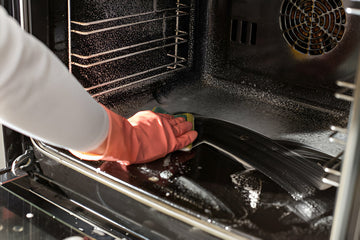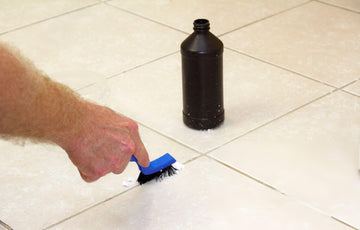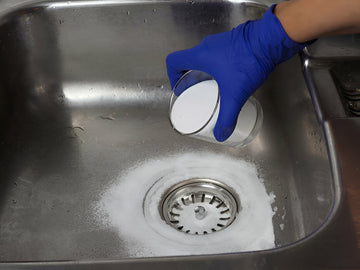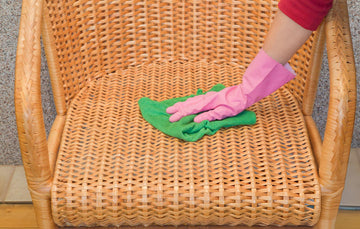Bathrooms are high-traffic areas, often filled with moisture and soap residue. These conditions can lead to mold, odors, and stains on sinks, showers, and floors. Neglecting cleaning can harm the environment and bathroom fixtures. Now you might be wondering, 'how do I clean the bathroom.'
Keeping your bathroom clean isn't just about appearances—it helps maintain a healthier environment and prolongs the life of your fixtures. From scrubbing sinks to tackling stubborn shower grime, we'll guide you through the best ways to deep clean every corner.
What Should You Know About Bathroom Cleaning Safety?
Cleaning your bathroom is essential for maintaining hygiene, but it's equally important to prioritize safety while doing so. Mishandling cleaning products or neglecting basic precautions can lead to harmful accidents. Here are some essential bathroom cleaning safety tips to keep in mind:
- Ensure proper ventilation: Use ventilation options such as opening windows, or turning on exhaust fans, in a bid to avert the poisonous fumes.
- Use protective gear: Always wear gloves for protecting hands from strong chemicals, goggles to protect eyes and a face mask to protect the lungs from inhaling bad particles.
- Avoid chemical reactions: Never put two cleaning products together, such as bleach and ammonia. This can create chloramine gas which is toxic in nature.
- Label DIY products: When making your own cleaners at home, always make it a point to labeling your containers so as not to be mixed up or mistaken for food.
- Retain original packaging: The original containers for the stored products should be maintained in their original packaging to preserve the safety information and times of expiring products.
- Secure storage: For cleaning products which might be toxic especially to children and pets, store them out of reach in cabinets or locked places.
- Ideal storage conditions: Store in a cool, dry place and away from direct sunlight and any source of heat to avoid leaks, evaporation, or chemical change.
Which Cleaning Tools Are Usefull in Bathroom Cleaning?
-
Microfiber Cloth
Perfect for wiping down mirrors, countertops, and faucets. -
Glass Cleaner
Ideal for cleaning mirrors and glass shower doors for a spotless shine. -
Distilled White Vinegar
Great for removing hard water stains and soap scum from tiles and fixtures -
Dish Soap
Useful for scrubbing bathtubs and sinks to remove grease and grime. -
Vacuum Cleaner
Handy for removing hair and dust from bathroom floors before mopping. -
Microfiber Mop
Helpful to easily attract and trap dirt, dust and debris. -
All-purpose Cleaner
Suitable for cleaning countertops, walls, and other hard surfaces. -
Toilet Brush
Essential for scrubbing the inside of the toilet bowl. -
Bathroom Cleaner
Designed for cleaning and disinfecting sinks, tubs, and tiles. -
Scrub Brush
Effective for tackling tough stains and grime on grout and tiles. -
A Plastic Bag
Useful for covering shower heads to soak in vinegar for descaling. -
A Squeegee
Keeps the surface streak-free. -
Disinfectant
Necessary for sanitizing high-touch surfaces like handles, light switches, toilet seats and tools.
Step-by Step Bathroom Cleaning from Top To Bottom
Unclog the Shower Head
Shower Heads can be a hidden source of germs. Over time, they can harbor Mycobacterium avium, a pathogen linked to pulmonary diseases. When you turn on a neglected shower, millions of germs could spray into the air and potentially into your lungs.
To tackle this, start with a simple cleaning method. Fill a plastic bag with enough white vinegar to submerge the showerhead nozzle. Secure the bag around the showerhead and let it soak overnight. In the morning, remove the bag and run water through the showerhead to rinse away the residue.
Wash Down Shower Curtains
Germs from your shower head and body can settle in your tub and shower area. Over time, they create a breeding ground for soap scum, mildew, and odors.
Start by deep cleaning your shower curtain and liner. Toss them into the washing machine with your regular detergent and a few old towels. The towels help scrub off grime and mildew. Once clean, rehang them to dry.
For cleaning glass shower doors, mix a paste using baking soda and a few drops of distilled white vinegar. Spread the paste directly on the door, and let it sit for an hour. Then, scrub it with a microfiber cloth, rinse, and buff it dry with a clean cloth. To prevent buildup, spritz all surfaces regularly with a shower cleaner to combat mold, soap scum, and hard water stains. To prevent streaks on the shower door, use a squeegee.
Your tub needs less attention—usually, a weekly scrub is enough. For extra shine, fill the tub with hot water, drain it, and apply a bathroom cleaner. Let it sit for 15 minutes before scrubbing. Don't forget to clean your shower caddy as well. Use a soap scum remover to keep it free of buildup.
To keep your bathroom fresh, wipe down all surfaces after showering. Open the window for an hour daily to reduce humidity and prevent mold growth.
Revive Grout Lines
Grout is porous, which makes it an easy target for bacteria and grime. Over time, it can become discolored and harbor germs if not cleaned regularly.
To clean your grout, use a scrub brush dipped in straight bleach to scrub away any stains or discoloration. Make sure to rinse thoroughly afterward and ventilate the room while working with bleach.
To keep grout in good condition, seal it every six months. This helps prevent moisture and dirt from seeping in. For stubborn stains on grout and tiles, a quality tile and grout cleaner can make the job easier and more effective.
Wipe Down Surfaces and Walls
Soap, along with dirt and skin cells, leaves behind a thin, invisible film on bathroom surfaces. Over time, this can lead to grime and buildup.
To clean thoroughly, spray your countertops, walls, and ceiling with an all-purpose cleaner. Then, turn on the shower and crank up the hot water to create steam. Let it run for about five minutes until the room is steamy. Turn off the water, close the door, and let the steam and cleaner work together for 20 minutes. Afterward, wipe down all surfaces with a clean cloth. For high spots, use a dry microfiber cloth. Finish by cleaning the tile floor once everything else is done.
Scrub Away The Floor Germs
Don't forget about those germs on the floor that will spread to your home with your feet. Are you unsure about cleaning the floor? Well, read this guide on "how do you clean a bathroom floor” and you'll be all set. To clear out all the dirt and debris from the floor take a microfiber mop, dip it in hot water and clean the floor. The mop will clear away the dirt, while the hot water will additionally help with disinfecting the floor.
For stubborn mold and mildew, use a mold remover. To prevent watermarks on ceramic tiles, apply car wax once a year—it helps water bead and roll off. If you have untiled walls and ceilings, consider mildew-resistant paint for added protection.
Make the Toilet Gleam
Flushing a toilet can send bacteria like E. coli and salmonella into the air, as germs linger in the bowl even after flushing. When viewed in slow motion, the spray resembles a fireworks display, spreading onto surfaces like the seat, handle, and nearby areas. This makes it essential to clean regularly and take precautions to limit bacteria spread.
To clean the toilet effectively, pour a cup of baking soda into the bowl. Let it sit for a few minutes, scrub it with a scrub brush, and flush. For stubborn stains, use a damp pumice stone—it's tough on limescale but gentle on surfaces. In cases of heavy grime, try a small electric pressure washer on low settings to clean hard-to-reach spots, such as hinges.
The inside of the toilet bowl may have accumulated germs and stains, and sometimes you may have to cope with a clogged toilet. That's why use the toilet brush and plunger that will help you to scrub away the stains, and open the clogged toilet, ensuring smooth flushing.
Always close the lid when flushing and use the vent fan to minimize airborne bacteria. Store toothbrushes and contact lenses inside a cabinet for added safety.
Polish the Bathroom Sink
The sink drain is a top contender for the most bacteria-ridden spot in the bathroom, even more so than the toilet seat. The bacteria in the drain are similar to those on a cutting board used for raw meat. And don't forget the faucet handles—they're touched right after using the toilet and before washing your hands, making them a prime spot for germs.
To clean effectively, you don't need harsh chemicals. Simply pour white vinegar or baking soda down the drain and flush with hot water. For the faucet, Gerba suggests using disposable disinfecting wipes, which are more effective than cloths in reducing bacteria.
If you must use clothes, be careful about where they're used and stored. After cleaning the faucet, use floss to clean the narrow space between the base and the taps. Finish by wiping down the bathroom mirror with glass cleaner for a complete clean.
Wash Towels and Clean Bath Mats
Towels can trap moisture, creating an environment for bacteria to thrive. Sharing towels only increases the risk. To reduce bacteria buildup, wash towels regularly. If your washing machine has a sanitizing setting, use it. Otherwise, add bleach to the wash. Replace towels every three to four days to keep them fresh.
When drying towels, avoid using hooks where moisture can get trapped in folds. Instead, spread them out on a bar to allow air circulation. The towel bar itself can collect bacteria, so clean it often. Also, don't hang towels near the toilet to prevent bacteria from the flushing spray.
Bath mats should also be cleaned frequently with a carpet sweeper, as they can quickly become breeding grounds for germs. Keeping your towels, bars, and mats clean is essential for maintaining a hygienic bathroom.
Sanitize the Ventilation Fan
The bathroom fan helps reduce mold and mildew but also collects airborne particles that settle on the blades and vent. To clean it, start by flipping the circuit breaker off for safety. Remove the cover and soak it in warm water with dish soap. Use a vacuum cleaner with a nozzle attachment to remove dirt from the fan blades, then wipe them down with a damp cloth. Dust the motor and other hard-to-reach areas with a stiff paint brush and vacuum up the debris. Once everything is dry, replace the cover.
For better moisture control and energy efficiency, consider installing a switch timer. A handyperson can easily do this. Set the timer to run the fan during each shower and for 30 minutes afterward to reduce moisture buildup and keep your bathroom fresh.
Disinfect Cleaning Equipment
Disinfecting your cleaning equipment with a disinfectant after cleaning bathrooms stops the spread of germs. Clean the toilet brush, mop, and sponges by soaking in a bleach solution for 10 minutes. Rinse them thoroughly and let them air dry completely to avoid bacterial growth. Wipe down reusable gloves and buckets with disinfectant wipes or spray. Always store your equipment in a clean, dry area to keep it sanitized for future use.
Why Do You Need to Clean A Bathroom?
The prime purpose of cleaning a bathroom is to ward off harmful microorganisms. Bacteria and viruses can survive for up to a week on bathroom surfaces, leading to illnesses like strep throat, salmonella, and athlete's foot. Germs thrive in warm, moist areas like toilets, sinks, and shower floors, making regular cleaning essential to prevent health risks.
Common bathroom germs include E. coli, salmonella, and staphylococcus aureus. E. coli can cause serious infections, while salmonella spreads through contaminated hands or surfaces, leading to stomach issues. Staph bacteria can lead to skin infections. Regular cleaning helps remove these harmful germs, reducing the risk of illness and keeping your bathroom safe and hygienic.
How Frequently Should You Clean Your Bathroom?
Maintaining a clean bathroom is essential for both hygiene and comfort. For everyday cleanliness, focus on high-touch areas like the toilet, sink, and shower. Cleaning these spots once a week helps remove bacteria and prevents the buildup of soap scum. Also, wipe mirrors, faucets, and handles to keep everything shining.
Every 4 to 6 weeks, schedule a more thorough cleaning session to address areas that are easy to overlook, such as behind the toilet and inside cabinets. Scrub the grout, wash the exhaust fan, and clear any built-up dust. This deep clean eliminates hidden dirt and mold, keeping your bathroom sanitary and looking its best. A consistent routine ensures a cleaner, safer space for you and your family.
Do you find it difficult to clean your bathroom? Well, don't worry; here's a quick checklist for you to deep clean your bathroom:
- Unclog your shower head with white vinegar.
- Put your shower curtain and liner in the washing machine to wash.
- Remove stains from grout using a scrub brush dipped in bleach.
- Clean buildup and grime from walls and other surfaces.
- Clean the toilet to remove germs.
- Use white vinegar and baking soda to polish the sink.
- Wash towels and bath mats in the washing machine.
- Sanitizing the ventilation fan.
- Don't forget to disinfect the cleaning equipment to make it germs free for next clean.
Looking for Quality Cleaning Supplies? Here's What You Need
Yocada has been making cleaning easier for families though providing premium cleaning supplies for 38 years. Our design team creates simple, effective cleaning tools used by thousands of households. We are committed to delivering convenience and cleanliness, helping you maintain a healthier, more hygienic home.
Keep Your Home Spotless – Explore our collection of cleaning supplies and give your family the clean, fresh space they deserve!
Final Words
Cleaning your bathroom regularly is a simple yet effective way to maintain hygiene and prevent illness. By sticking to a cleaning routine, you're making a positive impact on your health. Start today, and enjoy a cleaner, healthier bathroom every day.











